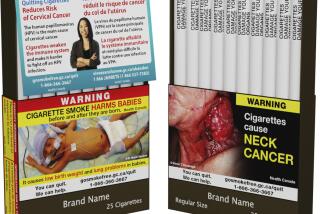Let the Public Be Warned : Consumers Deserve a Chance to Act When Told of Danger
- Share via
The suspicion of sabotage in the destruction of Pan American World Airways Flight 103 places front and center the question: What is the obligation of a company to warn customers about dangers associated with its products or services?
In this case an anonymous call two weeks in advance alerted the authorities about a bomb that would be placed on a Pan Am flight originating in Frankfurt, West Germany. The U.S. government sent a written warning to its embassy personnel in Europe and notified airlines and airports, but neither Pan Am nor the government alerted the flying public.
When queried about this double standard, one official complained, “We’d have to close down the airports if we informed the public of all threats made.” Another said, “We get dozens of threats each day.”
The FBI now says that the call was a hoax. But one father of a passenger killed on Flight 103 believes that the customer should have the right to choose whether to take a risk based on the best information available. In this case, if the government warned its embassies, either it or Pan Am should have also warned the public. At present, there is no federal requirement that airlines warn customers about threats of sabotage. It is time to reconsider this omission.
From a social perspective, warning of dangers is a basic responsibility of a company selling products or services to the public. But, with rare exceptions, most corporate executives resist disclosure of unpleasant information about the company--even when others are placed at risk. They don’t want to damage the confidence of consumers in their company or its products. But, as in the case of Flight 103, consumer confidence is even more severely undermined when the public discovers that it was denied critical information.
In part because of this penchant for secrecy, the courts and Congress have found it necessary to force companies to disclose critical health and safety information to the public. For example, when it was discovered in 1966 that auto manufacturers were covering up information about serious safety defects in their cars, Congress enacted notification requirements that made any future failure to disclose a safety defect an intentional violation of federal law.
The courts have again and again required companies to pay damages to injured individuals who were not warned about product or service dangers. And juries, as in the Ford Pinto gas-tank case, have imposed punitive damages where companies knew of hazards but failed to tell the customer or take remedial action. Federal agencies regularly issue regulations requiring the disclosure of critical facts about the use and misuse of products, even when there is no life-threatening problem. For example, products containing sugar or salt and other ingredients must be labeled.
The American public strongly supports such disclosure and relies on a presumption that products and services are safe. There is a general belief that the public should and will be warned about dangers, and outrage when it is not.
Yet, despite this widely held public view, corporations vigorously resist government requirements for warning the public. Thus, even after it was documented that hundreds of children each year with flu or chicken pox would get the often-fatal Reyes’ syndrome when taking aspirin,the aspirin industry resisted any federal warning-label requirement. And the drug industry similarly got the Reagan Administration to dump a requirement, developed over 10 years, for package inserts telling prescription-drug users about possible side effects and adverse reactions.
Refusal to tell the public of product or service dangers does not ensure that the adverse information will not be disclosed. In fact, it often seeps out, particularly if many people are affected. And when crucial safety information finally does become public, consumers stop buying the product because there is distrust of the company that refuses to inform customers of hazards. The Corvair, Pinto and Audi 5000 automobiles and the Firestone 500 tires are testimony to the marketplace downside of this strategy of secrecy.
There is, of course, legitimate concern about public overreaction to information on product or service hazards. The constructive approach taken by Johnson & Johnson over the Tylenol sabotage scare is a helpful model. The problem resulted in limited damage to the company and the development of new protections for the public. In that case the company removed millions of containers from the marketplace to catch perhaps only a few contaminated ones, and it developed a new seal to prevent such misbehavior in the future. Now many companies similarly seal their products.
Surely experience has shown that the public can and usually does act responsibly when informed of dangers, and that companies suffer when they cover them up. The tragedy with Pan Am Flight 103 is a striking reminder of the need to confront corporate reluctance to inform the consumer. It will take time to determine whether Flight 103 was a disaster that we could have prevented, but surely the travelers who might pay with their lives are entitled to complete information about the risks that they are about to undertake.
More to Read
Inside the business of entertainment
The Wide Shot brings you news, analysis and insights on everything from streaming wars to production — and what it all means for the future.
You may occasionally receive promotional content from the Los Angeles Times.









